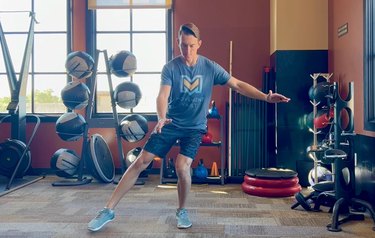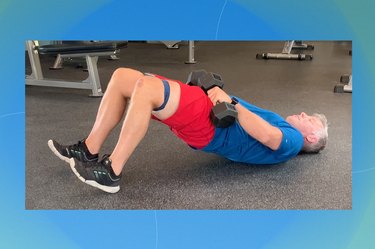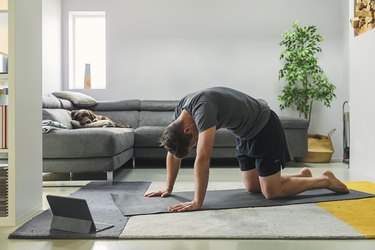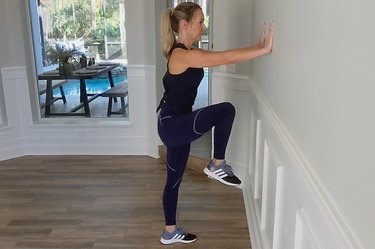

Real talk: We'd all like to slow the hands of time. Who doesn't want to feel young, fit and healthy into older age?
How we exercise in our younger years makes a big impact later in life. Especially if we're strategic about the workouts we choose. For instance, routines that strengthen muscles in our hips and glutes — which are essential for mobility, stability and balance — become especially important as we age, says Grayson Wickham, DPT, CSCS, a certified strength and conditioning specialist, physical therapist and founder of the Movement Vault.
Video of the Day
One body-weight movement you've probably never heard of — called the around the clock — does all that and more. The exercise involves standing on one leg and extending your opposite leg behind you, to the side and then in front of you like a clock hand. If you're thinking that sounds like a whole lot of lower-body work, you're right.
While around the clocks can't turn back your aging clock, they can help you grow older more gracefully by building balance, stability, strength and mobility in your lower body, Wickham says. This also translates to a lower probability of pain and injury in your hips, knees, ankles, backs and/or feet, he adds.
And you don't need to be an older adult to start. The benefits are brilliant at every age.
How to Do the Around The Clock
Around the clocks are convenient — all you need is your own body weight and a can-do attitude to get cooking. Try doing around the clocks two to three times per week as part of your regular strength-training workouts.
Focus on extending your moving foot as far as possible in each direction, Wickham says. The more distance you cover, the greater the challenge for your balance and lower body strength.
Around The Clock
- Stand up tall with your right foot firmly planted into the ground. Your goal is to keep your entire foot, including your heel and toes, pressed into the ground the whole time.
- Lift your left foot a few inches off the ground. This will be your moving leg.
- Bend your right leg — making sure your right knee stays tracking over the middle of your foot — and tap your left foot behind you then back to the center. Next, tap your foot slightly across behind you, keeping your hips square to the front, then back to the center.
- Next, tap your left foot straight in front of you, and begin moving your way “around the clock,” tapping your foot to each “number” on the clock, moving to the side until you reach the back again.
- Then work your way back around the clock until you return to the front.
- Switch legs and repeat on the other side.
Why the Around The Clock Is the Best Body-Weight Exercise You Can Do for Healthy Aging
1. It Strengthens Your Hip and Glute Muscles
Around the clocks activate and strengthen all the muscles around your hip, including your glutes and hip rotators, Wickham says.
Having strong glutes and hip rotator muscles is essential for performing most types of movements (think: standing, sitting, walking, running, climbing stairs, etc.) and reduces your risk for hip, knee and/or back pain, he says.
2. It Works Your Quads
The muscles around the front of your knee, mainly your quadriceps, also get a lot of action during around the clocks, Wickham says.
Building strong, stable quadricep muscles is vital for knee joint health, especially as you age. "When you have strong quadricep muscles, your knee joint resiliency increases, which will decrease your chances of knee pain and/or injury," Wickham explains.
3. It Builds Single-Leg Balance
Around the clocks require a lot of single-leg balance: While one leg moves in multiple positions, your other must keep you upright and steady, or else you'll fall.
"All your hip stabilizing muscles will be firing and activating to keep your non-moving leg stable," Wickham says.
"Single-leg balance and stability are crucial at every stage of life, but more so as you get older," he says. That's because single-leg balance carries over to almost any daily task or activity that involves being on your feet or shifting your weight. For example, you need it when you step into a tub or climb a staircase.
By building your balance and stability, you can help maintain your independence as you age.
4. It Helps Prevent Falls
"Falls are a big problem, especially for [older adults]," Wickham says. And the stats back him up. In fact, one in four older Americans will fall each year, and one in five falls causes an injury, such as broken bones or a head trauma, according to the Centers for Disease Control and Prevention.
Around the clocks — which are essentially balance training and strength work all in one movement — improve your stability and build a strong lower body. Both are necessary for keeping you steady on your feet and avoiding the risk of a fall.
5. It Improves Ankle Mobility
"Around the clocks are also great for ankle mobility," Wickham says. While you may not give your ankles much thought, you should: they play a pivotal role in functional movement patterns.
Ankle dorsiflexion — the ability to draw your toes toward your shins — is important for almost every leg movement and exercise, from walking to running, Wickham says.
It's important for doing squats, too. Yep, if you have limited range of motion in your ankles, your squats will suffer. That's because stiff, inflexible ankles affect your squat depth, according to a March 2015 study in the Journal of Human Kinetics.
And many people tend to have tight, restricted ankles, Wickham says. That's where around the clocks come in – they stretch out and contract all the muscles in the back of your ankle and lower leg, so that you'll be maximally dorsiflexing your ankle during the movement, he says.
By working on your ankle dorsiflexion skills, you can improve your range of motion in these areas and, subsequently, enhance your performance (believe us, your squats will thank you).
Was this article helpful?
150 Characters Max
0/150
Thank you for sharing!
Thank you for your feedback!


